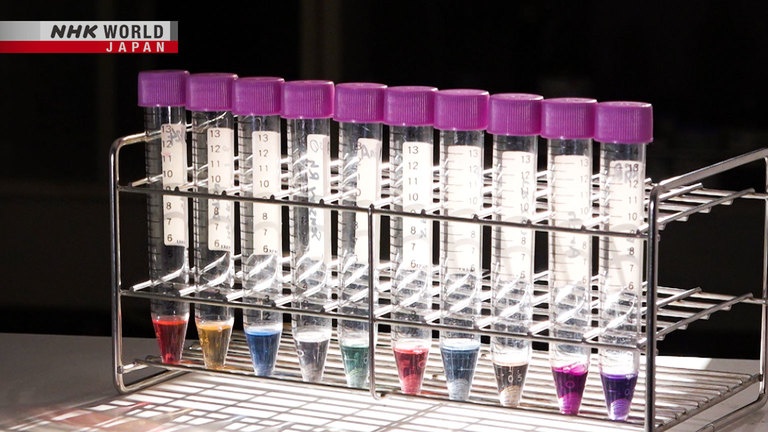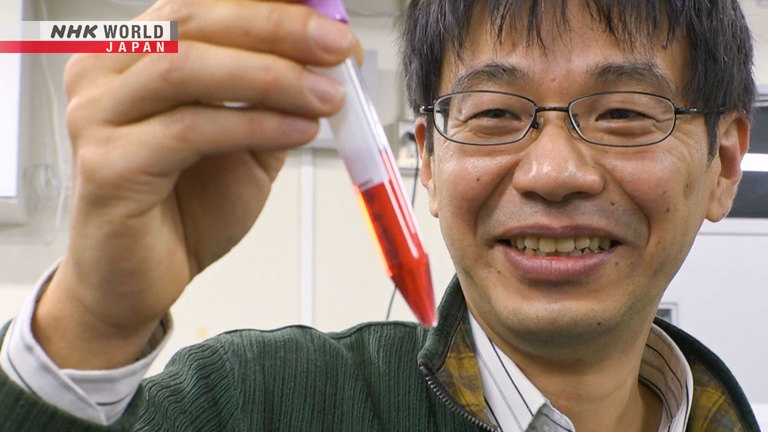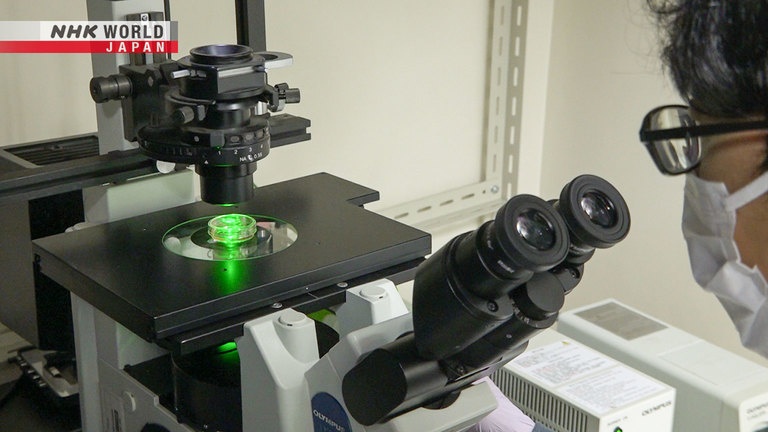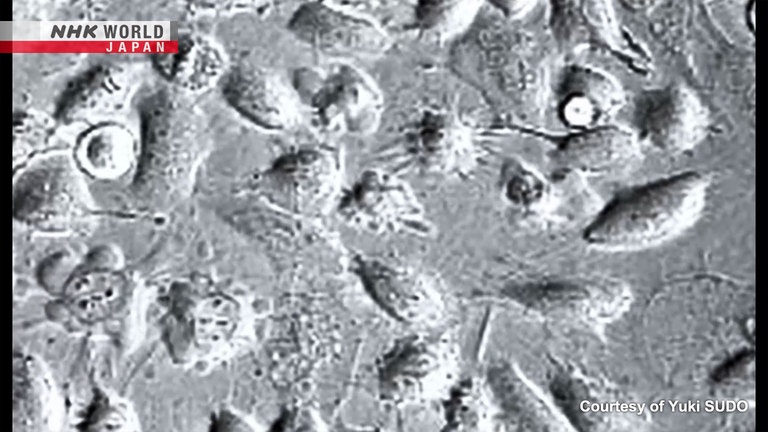Rhodopsin: From Light into Medicine
Considerable time and funding are required in development of new medicines necessary for otherwise untreatable illnesses. Professor Yuki SUDO of Okayama University seeks an innovative form of treatment using rhodopsin, a protein with light-reactive qualities. By extracting it and artificially inserting it into affected cells, it could treat illness simply by exposure to a specific type of light. He has succeeded in using rhodopsin to eliminate cells from cancer, the first such accomplishment ever achieved in the world. In this episode, we introduce the research toward a "light switch" to cure disease.




Transcript
This is a pharmaceutical laboratory at Okayama University.
The research being performed here...
is on this substance.
The colors among these vials represent important research.
These ones came from our laboratory.
This one came from the ocean near Ogasawara.
This is from a saltwater lake in Spain.
I believe this one is from Yellowstone National Park.
Hundreds of varieties with different colors have been discovered in nearly a dozen countries worldwide.
All of them are variations of a single substance.
Rhodopsin is a photoreceptor protein, meaning that it reacts to light.
It's beautiful. I love looking at it.
Dr. Yuki SUDO is a professor at Okayama University and one of the foremost experts on rhodopsin in Japan.
He's currently involved in groundbreaking research into rhodopsin's light-reacting properties.
Rhodopsin can do things like create energy
and adjust osmotic pressure.
I want to use different kinds of rhodopsin within the body.
Reacting to different lights,
it could treat a variety of diseases.
His research is linked to the difficulties in developing new medical treatments.
Prices of new drugs have increased, leading to disparities in health care.
To combat this, SUDO wants to revolutionize the development of medicine.
One example is cancer.
Rhodopsin's reactivity to light gives it great potential in treatment of model cancer cells.
It can destroy the cells from within.
This experiment attempts to treat cancer without affecting the healthy cells nearby.
Successfully using rhodopsin to eliminate cells was a worldwide first.
The motto of the research is "changing light into medicine."
We could possibly reduce headaches
by sleeping under blue light.
Or use red light to relieve foot pain.
Such treatments would change the world.
Perhaps we could treat skin cancer
by applying rhodopsin and shining light on it.
Light is completely unlike the kind of
synthetic capsules people envision in pharmaceuticals.
It would be incredible
if we could simply apply some light to cure people.
SUDO continues his work to realize a kind of "light switch" that can be used in treatment.
Even today, many diseases remain difficult to treat.
Up to 95 percent of rare diseases lack even medicines for treatment, but research is continuing.
Such research is becoming more difficult with each passing year.
The average cost to bring a new drug to market is around 2.6 billion US dollars.
Likewise, the average time required for research and development is more than 10 years.
This has led to a search for new innovations in medicine development.
SUDO has looked to the possibilities of using light and rhodopsin.
Though it may appear colorful, these are not the hues of the rhodopsin itself.
This rhodopsin appears orange.
But it only appears that way because
it's absorbing colors other than orange.
Rhodopsin types absorb different wavelengths.
Each type of rhodopsin has a certain wavelength of light that is not absorbed.
Its color is determined by that unabsorbed wavelength.
With its uniquely colorful appearance, what role does rhodopsin play within living beings?
Rhodopsin is a type of protein that is found in cell membranes.
It's an essential substance used by various species in absorbing light.
From humans to microorganisms, the applications of rhodopsin are incredibly diverse.
Humans specifically use it for vision.
Rhodopsin exists in our retinas, allowing them to perceive differences in light and color.
When light reaches our eyes the rhodopsin reacts with it, helping us to see.
Rhodopsin is also used by microbes for phototaxis.
Even without eyes, the microbes can use rhodopsin reactions to move to or from light.
Rhodopsin has even more uses in other species.
Its varieties are thought to number in the tens of thousands.
By artificially introducing Rhodopsin into cells and shining light on them, Dr. SUDO is attempting to find new ways of curing diseases.
First, he demonstrated to us how rhodopsin is applied.
Rhodopsin's genetic material is inserted into test cells.
A few days later, it can be detected within the cells.
This is an image of the cells.
A special marking agent is used...
Then, rhodopsin clearly comes into view.
This is just one example of its use.
We can use similar methods to insert rhodopsin
into cultured cells and animal cells.
Consider some of the disease treatments where rhodopsin could be used...
One area is nervous system research.
The tiny worms known as nematodes are commonly utilized.
Rhodopsin harvested from algae appears green in this picture of nerve cells.
An astonishing reaction occurs when light is applied to the nematodes.
At first, they're moving normally...
But nematodes' movement stops as soon as they're exposed to the light.
They start moving again when the light is off.
The abrupt change in movement is related to the flow of electrically charged particles called ions.
Electrical current is conducted by all cells in living beings, including neural cells in the brain.
It's ions that regulate this balance.
By introducing negatively charged chloride ions into nematodes, the electric potential of their cells becomes negative, suppressing neural activity.
Similarly, their release creates positive potential with increased neural activity.
Rhodopsin is closely related to this flow of ions.
Ions flow when illuminated, and are limited when the light is turned off.
The absence or presence of light allows the nematodes' movement to be controlled.
Disruption of electrical signals
can cause a variety of illnesses such as depression.
It can also affect our memory,
learning, sleep cycles, and other basic functions.
Depression involves an abnormal neural response in the cell.
We could remedy the depression by suppressing it.
Humans depend on a number of reactions to function.
If they become abnormal,
we could use light and rhodopsin to bring them back to normal.
The term for controlling cells through a substance that reacts with light is "Optogenetics."
SUDO is a top expert in Japan on this subject.
His other experiments include applying light to activate medicine inside the body with a specific timing.
The work includes fields not solely related to medical fields.
The purpose of this experiment is to increase algae for production of biofuel.
The left one doesn't contain rhodopsin, while the right one does.
Although environmentally friendly, biofuel is costly to produce.
His research is still in progress, but SUDO has successfully induced growth of algae cells simply by introducing rhodopsin and light.
In the future, this development could revolutionize energy resources.
To go into detail, biofuel might cost around $5 per liter.
With rhodopsin, we can double the number of biofuel cells,
effectively halving the cost.
We could even make it cheaper than
that with further developments.
SUDO's experiments range from medicine to energy resources and beyond, opening up a seemingly limitless realm of possibilities.
Rhodopsin has life-changing capabilities.
Those possibilities are almost endless.
I want to look into more ways
we can use the potential of rhodopsin and light.
SUDO first started his research in the late 1990's when he was still a student of pharmaceutical science.
The first lecture I attended as a student was startling.
Making medicine takes a lot of time and money,
but chances of success are low.
That difficulty made me want to devise new methods
of creating medicine.
Anything that makes changes
in the body can act as medicine.
Even music can have soothing properties.
So I wanted to expand our perception of medicine,
and utilize light as a form of it.
These goals led to SUDO's awareness of the reactive properties of rhodopsin.
At the time, only a few variants of rhodopsin were known, mostly those inside the cell membranes of humans and a selection of animals.
SUDO took notice of a more unusual variant found in microbes.
It led him to consider what other types might exist.
A textbook's chapter on vision had a picture
of a saltwater lake in California.
The lake contained organisms called archaebacteria,
and their rhodopsin is similar to that of humans.
This was an encouraging discovery.
It demonstrated that less evolved organisms also
had light reaction abilities.
It also proved that rhodopsin can exist in organisms
that evolved along totally different paths.
SUDO has traveled to Asia, the United States, and Europe to study microbes.
He searched in bodies of water such as rivers and lakes to seek microbes containing rhodopsin.
At a time when only several dozen types were known, his search resulted in the discovery of hundreds of rhodopsin varieties.
During SUDO's research, interest in rhodopsin was progressively increasing worldwide.
In the year 2000, rhodopsin found in ocean microbes led to a new discovery in the use of light on Earth.
Until then, the known uses for light from the sun were functions such as photosynthesis, as well as atmospheric reflection and absorption.
Today, sea organisms are also known to use rhodopsin to turn light into energy.
Hailed as "a new type of photosynthesis," this function brought significant attention to rhodopsin.
Tens of thousands of rhodopsin varieties have been identified, and this attention owes greatly to SUDO's discoveries.
We accompanied SUDO to observe his methods for seeking out types of rhodopsin.
This hot spring is a drive of an hour and a half from Okayama City.
Organisms and their proteins respond to the environment.
This means that you have to first look
in different environments.
If the surrounding temperature is high,
we can probably find proteins with heat stability.
Then we could achieve something like solar power generation.
With heat-stable rhodopsin,
converting light into energy that way might be possible.
So this is something like a treasure hunt.
Following his worldwide treasure hunt for microbes...
At the laboratory, the samples are placed into a centrifuge.
Start.
Microbes are separated from other materials, and their cells are crushed.
Pure rhodopsin is gradually extracted.
Transparent liquid comes out first.
The colored liquid should come gradually.
After around 1 month, the rhodopsin is finally extracted.
This is rhodopsin that we extracted from another hot spring.
It's beautiful. I was astounded the first time I saw it.
It makes you smile.
Many such varieties of rhodopsin were discovered by SUDO using this method.
In his search for ways to turn light into medicine, SUDO has studied a wide range of rhodopsin.
In order to further this research, efforts are being made in an important field.
We hope we can use light to
destroy specific cells for cancer treatment.
Cancer has been the number one cause of death in Japan for 40 years, with approximately 380,000 deaths in 2020.
Side effects from anti-cancer drugs can cause major problems during treatment.
This includes damage to the healthy cells near cancer cells.
SUDO is researching apoptosis, the life function used to destroy cells that are no longer needed.
There are two main types of cell death.
One is when you bump your hand or foot
into something, and it turns red.
The whole area turns red,
not just the part that was hit.
So the vicinity becoming inflamed is
one type of cell death.
Another type is the self-inflicted
cell death called apoptosis.
For example, when a fetus first develops fingers,
apoptosis occurs.
It happens between the digits,
making five fingers separate.
Old cells in our bodies are replaced with new ones gradually.
Apoptosis causes this constant cycle to occur.
SUDO hopes that rhodopsin can be used to cause apoptosis in targeted cancer cells.
This experiment uses the AR3 variant of rhodopsin.
The rhodopsin was extracted from microbes in the Dead Sea, between Israel and Jordan.
It plays an important role in bringing about apoptosis.
We can use this rhodopsin to alkalize the inside of cells.
Your skin feels slippery after an alkaline bath
because certain cells have died.
I figured we could do the same thing with rhodopsin.
When AR3 is exposed to light, it carries hydrogen ions away from cells.
Intracellular hydrogen ion concentration is dropped, alkalizing it.
This phenomenon could cause apoptosis in cancer cells with AR3 inserted.
SUDO and his research team have started another experiment.
AR3 is inserted into cells from cervical cancer, then light is applied.
First comes the light...
Next, they await the results.
Three hours after applying light, apoptosis has occurred in most of the cells.
You can see the cells swelling and dying.
Most of the neighboring healthy cells are unaffected.
It's amazing to see this actually work!
Results have also been observed in cells from lung cancer and neuroblastoma.
This could potentially lead to treatments for a range of cancers.
In order to verify this apoptosis in animals, experiments are being performed on mice.
Before practical treatments become possible, methods must be developed for introducing rhodopsin to cancer cells and applying light inside the body.
As it stands, these are only the first steps toward treatment.
Cancer is the most common illness both in Japan
and the rest of the world.
Some cancer can be treated,
but generally it's very hard to cure.
If treatments using light become possible,
cancer could become just another illness.
We could realize a future in which it's easily treatable.
SUDO's ideas for implementation include everything from depression to energy production.
Uniting light and rhodopsin shines a new ray of hope on the future.
New challenges are important for research,
but unorthodox approaches might be more important.
This might seem strange at first,
but we need unusual methods to make new discoveries.
Until the unorthodox becomes the norm...
Professor SUDO's research forges ahead.